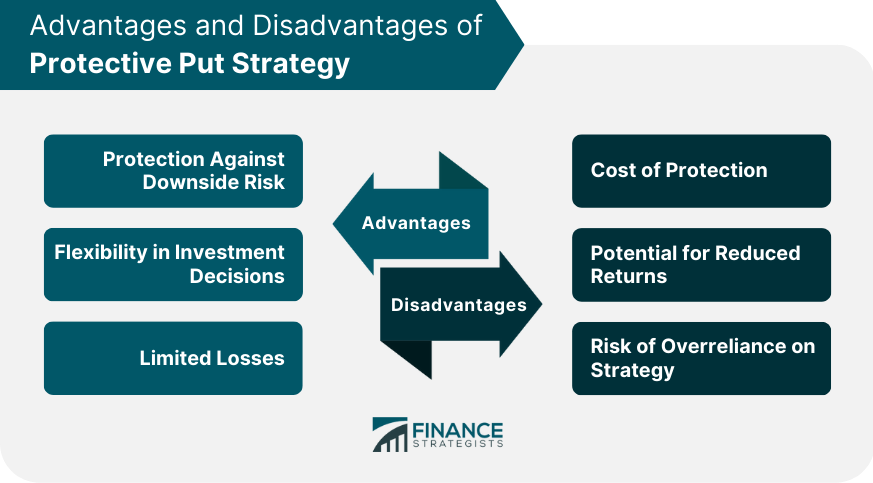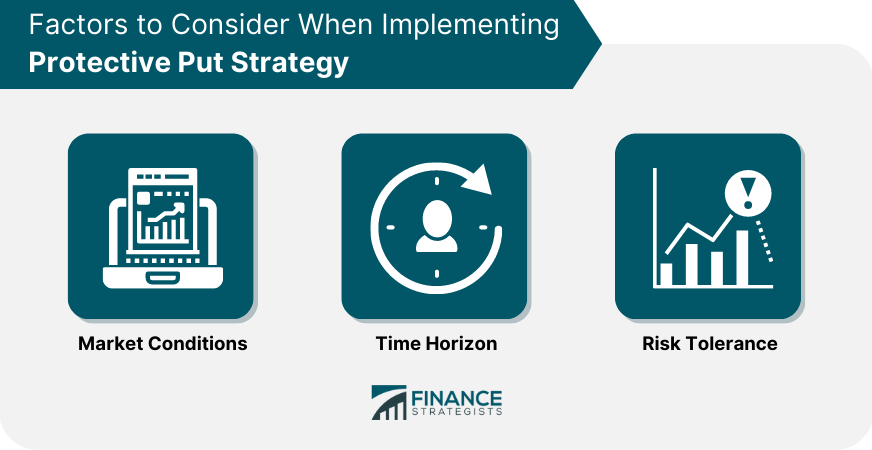The protective put strategy is an options trading strategy that is designed to protect investors from downside risk in their investment portfolio. The protective put strategy involves purchasing a put option on a security or portfolio of securities that is intended to offset any potential losses in the underlying asset. The purpose of the protective put strategy is to provide investors with a way to protect their portfolio from significant losses while maintaining the potential for upside gains. The protective put strategy is particularly useful for investors who are concerned about market volatility or who are holding a large position in a single stock. The protective put strategy involves purchasing a put option on a security or portfolio of securities that provides the investor with the right to sell the underlying asset at a predetermined price, known as the strike price, at any time before the expiration of the option. The key features of the protective put strategy include the purchase of a put option, the establishment of a strike price, and the expiration date of the option. The investor pays a premium for the put option, which provides protection against downside risk in the underlying asset. The protective put strategy works by providing investors with the ability to sell the underlying asset at a predetermined price, regardless of the market price of the asset at the time of sale. This provides investors with protection against significant losses in the underlying asset, while maintaining the potential for gains if the asset increases in value. The protective put strategy provides investors with protection against downside risk in the underlying asset. This can be particularly useful in volatile market conditions or for investors who are holding a large position in a single stock. The protective put strategy provides investors with flexibility in their investment decisions. Investors can maintain their exposure to the underlying asset while also protecting their portfolio from significant losses. The protective put strategy limits losses for investors by providing a predetermined price at which the underlying asset can be sold. This can be particularly useful for investors who are concerned about market volatility or who are holding a large position in a single stock. The protective put strategy can be costly for investors, as they must pay a premium for the put option. This can reduce potential returns and may impact the overall performance of the portfolio. The protective put strategy may result in reduced returns for investors, as the cost of the put option can reduce potential gains in the underlying asset. This can be particularly true in bull markets when the underlying asset is increasing in value. The protective put strategy may lead to overreliance on the strategy, which can limit the potential for gains in the underlying asset. This can also increase the overall cost of the portfolio and may impact the overall performance of the portfolio. Investors must consider market conditions when implementing the protective put strategy. The strategy may be more effective in volatile market conditions, while less effective in stable market conditions. Investors must also consider their time horizon when implementing the protective put strategy. The strategy may be more effective for short-term investors who are concerned about market volatility, while less effective for long-term investors who are focused on long-term gains. Investors must consider their risk tolerance when implementing the protective put strategy. The strategy may be more suitable for investors with low risk tolerance who are concerned about significant losses in their portfolio. An example of a protective put strategy on a single stock is as follows. An investor holds 100 shares of XYZ stock, which is currently trading at $50 per share. The investor is concerned about a potential decline in the price of the stock and purchases a put option with a strike price of $45 and an expiration date in three months. The investor pays a premium of $2 per share for the put option, which provides protection against any potential losses in the stock if the price falls below $45. If the price of the stock falls to $40 per share, the investor can exercise the put option and sell the stock at $45 per share, effectively limiting the loss to $5 per share. If the price of the stock increases above $45 per share, the investor can choose not to exercise the put option and maintain their position in the stock. An example of a protective put strategy on a portfolio is as follows. An investor holds a portfolio of technology stocks that is currently valued at $100,000. The investor is concerned about a potential decline in the value of the portfolio and purchases put options on each of the stocks in the portfolio. The investor pays a total premium of $5,000 for the put options, which provides protection against any potential losses in the portfolio if the value falls below $95,000. If the value of the portfolio falls below $95,000, the investor can exercise the put options and sell the stocks at the predetermined strike price, effectively limiting the loss to $5,000. If the value of the portfolio increases above $100,000, the investor can choose not to exercise the put options and maintain their position in the stocks. An example of a protective put as part of a trading strategy is as follows. An investor holds a long position in a stock that is currently trading at $50 per share. The investor is concerned about a potential decline in the price of the stock and purchases a put option with a strike price of $45 and an expiration date in one month. The investor pays a premium of $2 per share for the put option, which provides protection against any potential losses in the stock if the price falls below $45. If the price of the stock falls below $45 per share, the investor can exercise the put option and sell the stock at $45 per share, effectively limiting the loss to $5 per share. If the price of the stock increases above $50 per share, the investor can choose not to exercise the put option and maintain their position in the stock. The protective put strategy is an options trading strategy that provides investors with protection against downside risk in their investment portfolio. The protective put strategy involves purchasing a put option on a security or portfolio of securities that provides the investor with the right to sell the underlying asset at a predetermined price, known as the strike price, at any time before the expiration of the option. Investors must carefully consider the advantages and disadvantages of the protective put strategy and develop appropriate risk management strategies to minimize potential losses. Investors must also consider market conditions, time horizon, and risk tolerance when implementing the protective put strategy. The protective put strategy can be an effective way for investors to protect their portfolio from significant losses while maintaining the potential for upside gains. However, investors must carefully evaluate the cost of protection and the potential for reduced returns when implementing the strategy. The protective put strategy may be particularly useful for investors who are concerned about market volatility or who are holding a large position in a single stock.What Is Protective Put Strategy?
How Protective Put Strategy Works
Advantages of Protective Put Strategy
Protection Against Downside Risk
Flexibility in Investment Decisions
Limited Losses
Disadvantages of Protective Put Strategy
Cost of Protection
Potential for Reduced Returns
Risk of Overreliance on Protective Put Strategy

Factors to Consider When Implementing Protective Put Strategy
Market Conditions
Time Horizon
Risk Tolerance

Examples of Protective Put Strategy
Protective Put on a Single Stock
Protective Put on a Portfolio
Protective Put as Part of a Trading Strategy
Conclusion
Protective Put Strategy FAQs
A protective put strategy is an investment strategy used to protect against the downside risk of a security or portfolio.
A protective put strategy involves buying a put option for a security or portfolio. If the value of the security or portfolio decreases, the put option can be exercised to sell the security at a predetermined price, limiting potential losses.
The advantages of a protective put strategy include protection against downside risk, flexibility in investment decisions, and limited losses.
The disadvantages of a protective put strategy include the cost of protection, potential for reduced returns, and the risk of overreliance on the strategy.
A protective put strategy can be useful in situations where there is significant downside risk, such as during market downturns or when investing in high-risk securities.
True Tamplin is a published author, public speaker, CEO of UpDigital, and founder of Finance Strategists.
True is a Certified Educator in Personal Finance (CEPF®), author of The Handy Financial Ratios Guide, a member of the Society for Advancing Business Editing and Writing, contributes to his financial education site, Finance Strategists, and has spoken to various financial communities such as the CFA Institute, as well as university students like his Alma mater, Biola University, where he received a bachelor of science in business and data analytics.
To learn more about True, visit his personal website or view his author profiles on Amazon, Nasdaq and Forbes.











